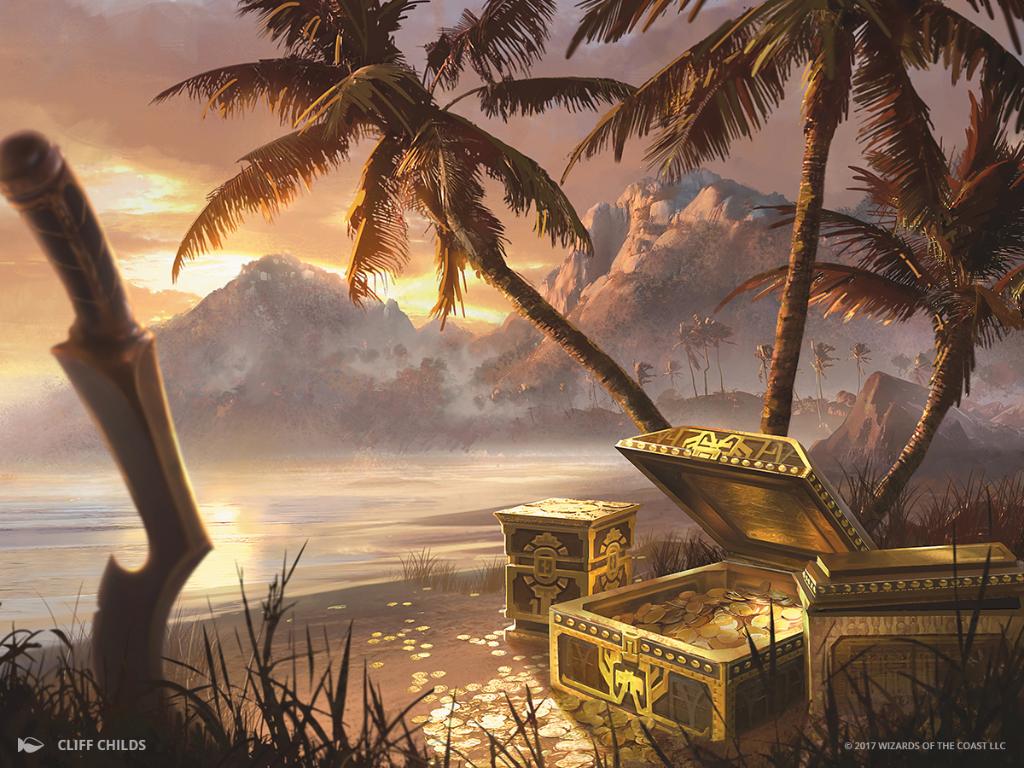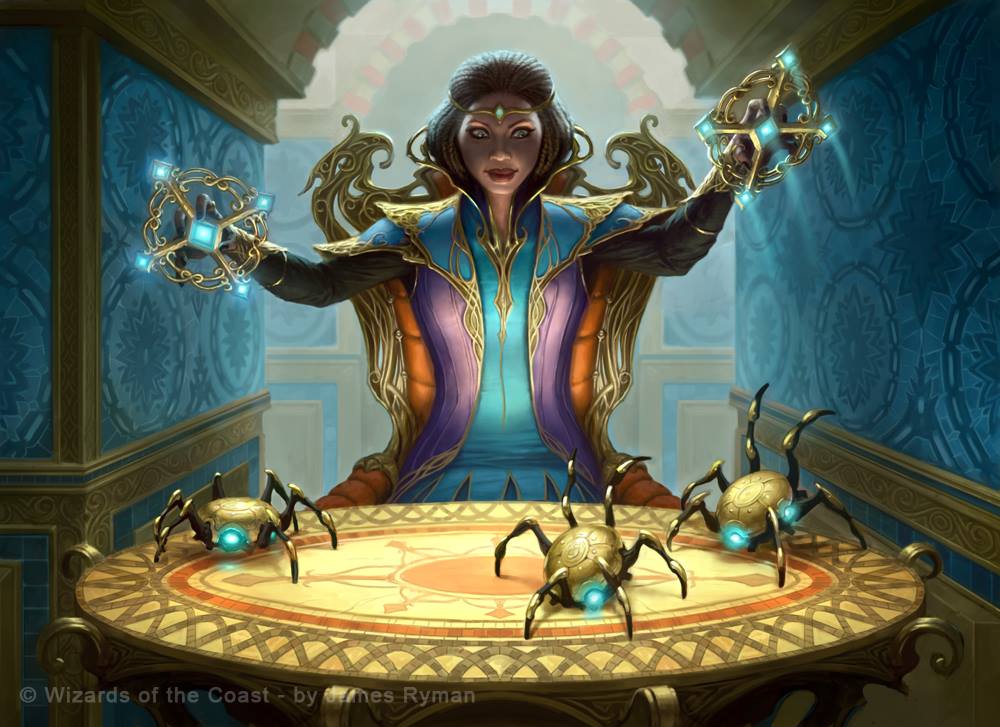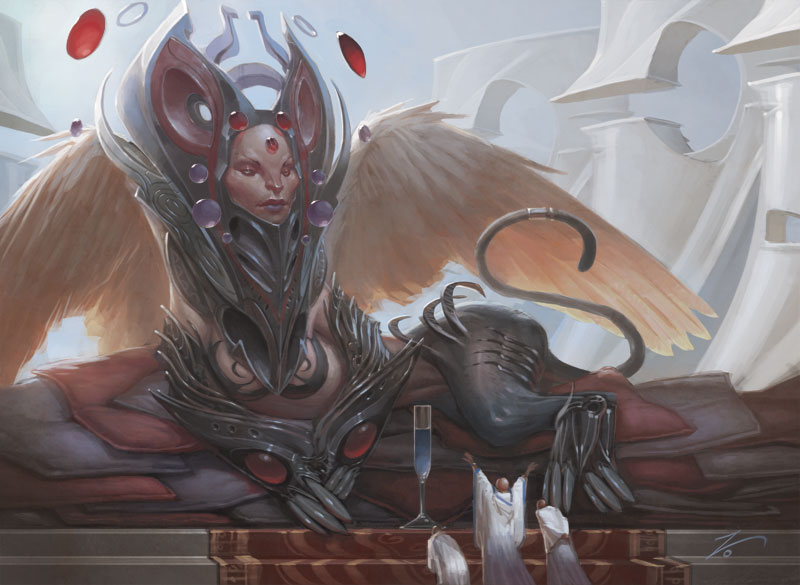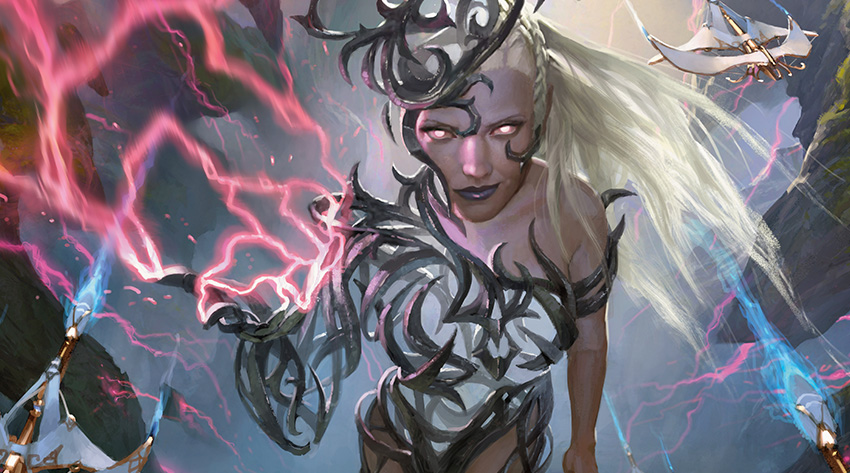(Breya, Etherium ShaperBreya, Etherium Shaper | Art by Clint Clearley)
Trash & Treasure for Value
Hi everyone! Welcome back to The Knowledge Pool, where we take a deep dive on deep commanders!
As many of you know, Breya, Etherium ShaperBreya, Etherium Shaper from Commander 2016 quickly became one of the most popular commanders in the entire format. The Magic community's collective infatuation with Breya was understandable, as there weren't many thematic options for an artifact-focused blue-red, Grixis, or Jeskai deck. Breya represented the perfect home for artifact cards in all of these color combinations, offering a powerful and open-ended ability with artifact synergy. Generally, I have a personal distaste for four- and five-color commander decks, and Breya's staggering popularity won her none of my favor. Upon release, I knew at least three people in my local meta brewing Breya decks, and I quickly grew sick and tired of hearing about her.
Now, three years following her release, I've revisitied Breya without the overwhelming hype that previously curbed my interest. There's a lot to unpack. First, there are seemingly endless archetypes around which we can focus a Breya deck, and unlike many of her four-color counterparts, her penchant for artifacts means we'll always have a through-line to keep our builds focused without the inevitable drift towards "goodstuff." That being said, artifacts are a historically powerful card type in Magic, and we can easily build a "goodstuff" Breya deck, if we so desire.
Breya also naturally slants towards combo-centric strategies: in my research into Breya decks, I've found builds that tout the ability to combo out in 65 ways, which is a testament to the power of both artifacts and the commander herself. The combo build is the version of the deck most players are probably aware of, but today I want to look at something a little different. We won't be eschewing combos, but I want to embrace a few of the other characteristics that make Breya appealing.

My deck was inspired by the linked primer, and aims to make use of the value aspects of Breya's ability. If we need two artifacts to sacrifice to Breya, why not sacrifice tokens? Luckily, there are many great artifact token creators that can generate tokens consistently and in great quantities. Thopters, Servos, and Treasure are our best friends, and Treasure in particular represents a powerful and versatile permanent that we can use to fuel our game plan. We won't have to look far for cards that synergize with our strategy: tons of cards thrive with expendable artifact fodder, so we have a plethora of outlets for our stockpiles of trash and treasure. There are also cards that will ping our opponents whenever our artifacts hit the bin, or whenever an artifact enters play, giving us a pseudo-Aristocrats flavor.
However there's one card archetype I'm particularly excited to try: alternate win conditions. A handful of cards exist with the text "you win the game" on them, and it turns out many of these exist in Breya's colors and benefit from an artifact token strategy. Will we often trigger these win conditions? Maybe not. But we will certainly have a series of unique options to keep our opponents on notice.
Have you ever been building a new deck, and then a new card gets spoiled that's absolutely perfect for your build? Has this ever happened to you three times during the same spoiler season? As I was building around Breya, Etherium ShaperBreya, Etherium Shaper I found myself blessed with three new home-run cards in Modern Horizons. Those of you who are up-to-date on the new set probably know the cards I'm referring to: Urza, Lord High ArtificerUrza, Lord High Artificer, Goblin EngineerGoblin Engineer, and Mirrodin BesiegedMirrodin Besieged. As we go, we'll talk about each of these cards in some detail, but given our focus on artifact tokens, the value these cards offer should be fairly obvious.
Without further ado, let's dive into this deck, and figure out what makes it tick. You can take an interactive look at my deck here.
Breya Trash and Treasure
View on ArchidektCreatures (18)
- 1 Hangarback WalkerHangarback Walker
- 1 Disciple of the VaultDisciple of the Vault
- 1 Goblin WelderGoblin Welder
- 1 Baleful StrixBaleful Strix
- 1 Goblin EngineerGoblin Engineer
- 1 Reckless FireweaverReckless Fireweaver
- 1 Eldrazi DisplacerEldrazi Displacer
- 1 Sai, Master ThopteristSai, Master Thopterist
- 1 Arcum DagssonArcum Dagsson
- 1 Padeem, Consul of InnovationPadeem, Consul of Innovation
- 1 Phyrexian MetamorphPhyrexian Metamorph
- 1 Pitiless PlundererPitiless Plunderer
- 1 Urza, Lord High ArtificerUrza, Lord High Artificer
- 1 Hellkite TyrantHellkite Tyrant
- 1 Marionette MasterMarionette Master
- 1 Sharding SphinxSharding Sphinx
- 1 Sharuum the HegemonSharuum the Hegemon
- 1 Thopter AssemblyThopter Assembly
Artifacts (17)
- 1 Mox OpalMox Opal
- 1 Nihil SpellbombNihil Spellbomb
- 1 Retrofitter FoundryRetrofitter Foundry
- 1 SkullclampSkullclamp
- 1 Sol RingSol Ring
- 1 Azorius SignetAzorius Signet
- 1 Dimir SignetDimir Signet
- 1 Fellwar StoneFellwar Stone
- 1 Izzet SignetIzzet Signet
- 1 Nim DeathmantleNim Deathmantle
- 1 Sword of the MeekSword of the Meek
- 1 Thopter FoundryThopter Foundry
- 1 Time SieveTime Sieve
- 1 Ashnod's AltarAshnod's Altar
- 1 Chromatic LanternChromatic Lantern
- 1 Sculpting SteelSculpting Steel
- 1 Krark-Clan IronworksKrark-Clan Ironworks
Enchantments (8)
- 1 Hidden StockpileHidden Stockpile
- 1 Mirrodin BesiegedMirrodin Besieged
- 1 Anointed ProcessionAnointed Procession
- 1 Mechanized ProductionMechanized Production
- 1 Smothering TitheSmothering Tithe
- 1 Storm the VaultStorm the Vault
- 1 Thopter Spy NetworkThopter Spy Network
- 1 Revel in RichesRevel in Riches
Instants (10)
- 1 DispatchDispatch
- 1 Enlightened TutorEnlightened Tutor
- 1 Swan SongSwan Song
- 1 Swords to PlowsharesSwords to Plowshares
- 1 Cyclonic RiftCyclonic Rift
- 1 Muddle the MixtureMuddle the Mixture
- 1 Anguished UnmakingAnguished Unmaking
- 1 Thirst for KnowledgeThirst for Knowledge
- 1 Fact or FictionFact or Fiction
- 1 Spell SwindleSpell Swindle
Sorceries (3)
- 1 Faithless LootingFaithless Looting
- 1 Cleansing NovaCleansing Nova
- 1 Austere CommandAustere Command
Planeswalkers (5)
- 1 Daretti, Ingenious IconoclastDaretti, Ingenious Iconoclast
- 1 Daretti, Scrap SavantDaretti, Scrap Savant
- 1 Tezzeret the SeekerTezzeret the Seeker
- 1 Tezzeret, Artifice MasterTezzeret, Artifice Master
- 1 Tezzeret, Master of the BridgeTezzeret, Master of the Bridge
Lands (38)
- 1 Academy RuinsAcademy Ruins
- 1 Ancient DenAncient Den
- 1 Arid MesaArid Mesa
- 1 Blood CryptBlood Crypt
- 1 Bloodstained MireBloodstained Mire
- 1 Cascade BluffsCascade Bluffs
- 1 Command TowerCommand Tower
- 1 Darksteel CitadelDarksteel Citadel
- 1 Exotic OrchardExotic Orchard
- 1 Fetid HeathFetid Heath
- 1 Flooded StrandFlooded Strand
- 1 GlimmervoidGlimmervoid
- 1 Godless ShrineGodless Shrine
- 1 Great FurnaceGreat Furnace
- 1 Hallowed FountainHallowed Fountain
- 1 Inventors' FairInventors' Fair
- 1 IslandIsland
- 1 Luxury SuiteLuxury Suite
- 1 Mana ConfluenceMana Confluence
- 1 Marsh FlatsMarsh Flats
- 1 Morphic PoolMorphic Pool
- 1 MountainMountain
- 1 Path of AncestryPath of Ancestry
- 1 PlainsPlains
- 1 Polluted DeltaPolluted Delta
- 1 Prairie StreamPrairie Stream
- 1 Rugged PrairieRugged Prairie
- 1 Sacred FoundrySacred Foundry
- 1 Scalding TarnScalding Tarn
- 1 Sea of CloudsSea of Clouds
- 1 Seat of the SynodSeat of the Synod
- 1 Spire of IndustrySpire of Industry
- 1 Steam VentsSteam Vents
- 1 Sunken HollowSunken Hollow
- 1 SwampSwamp
- 1 Urborg, Tomb of YawgmothUrborg, Tomb of Yawgmoth
- 1 Vault of WhispersVault of Whispers
- 1 Watery GraveWatery Grave
The Breakdown
My version of this deck sits at a lean 3.05 average converted mana cost, with our most populated CMCs being two-drops and four-drops at 14 apiece. These numbers have a few important implications, the first of which is that we should be skewing our ramp to drop on turn two. If we can hit a two-drop mana rock, we'll be set to cast Breya or any of our other four-drops on turn three. We may not always want to jam Breya immediately, but building our ramp package this way helps to keep our options open.
Including artifact creatures, artifacts are our most common nonland permanent type. This may not be a surprising revelation for a Breya deck, but more shocking to me was just how many creatures I wanted to include. Our relatively heavy creature count of 18 is a result of our token strategy. We have several creatures that can help us build tokens, and we have others that want to sacrifice our tokens to offer us value. In addition to creatures, there are a handful of enchantments and planeswalkers that will also synergize nicely with our value-oriented game plan.

I keep pointing out that we're a token-focused deck, but observant readers will likely notice that we are lacking in spells that generate a lot of bodies at once. Instead, I've focused on the consistent production of dudes over multiple turns. My vision for this deck is to play a grindier game, using tokens as a currency. While cards like Maverick ThopteristMaverick Thopterist, Whirler RogueWhirler Rogue, and Pia and Kiran NalaarPia and Kiran Nalaar offer armies in a can, they'll offer little once we've sacrificed their Thopters.
One last thing to keep in mind for this deck is the mana base. We're working with a four-color deck that lacks green to help us ramp and fix our colors. Mana rocks can help us fix our mana, but we won't have as much control over finding the right mana when we need it. Of course, we can tutor for the right rocks, but that's no fun. Instead, I've tried to be cognizant of our mana costs, and the resulting color breakdown. We're a primarily blue deck, with half of our costs requiring blue. Following blue, we have equal parts white and black, with a smaller amount of red. Fetch lands are a tremendous help with our fixing, but at their current prices I realize many players will be looking for cheaper options. With this in mind, we'll want to focus on additional UW and UB dual lands first, and the Esper, Jeskai, Grixis, and Mardu tri-lands could easily make an appearance here to help fill in some holes.
With the administrivia out of the way, let's dig into the details of this deck, starting with tokens.
Trinkets & Toys
Tokens
View on Archidekt- 1 Hangarback WalkerHangarback Walker
- 1 Retrofitter FoundryRetrofitter Foundry
- 1 Hidden StockpileHidden Stockpile
- 1 Thopter FoundryThopter Foundry
- 1 Daretti, Ingenious IconoclastDaretti, Ingenious Iconoclast
- 1 Mirrodin BesiegedMirrodin Besieged
- 1 Sai, Master ThopteristSai, Master Thopterist
- 1 Pitiless PlundererPitiless Plunderer
- 1 Smothering TitheSmothering Tithe
- 1 Storm the VaultStorm the Vault
- 1 Thopter Spy NetworkThopter Spy Network
- 1 Tezzeret, Artifice MasterTezzeret, Artifice Master
- 1 Urza, Lord High ArtificerUrza, Lord High Artificer
- 1 Revel in RichesRevel in Riches
- 1 Spell SwindleSpell Swindle
- 1 Marionette MasterMarionette Master
- 1 Sharding SphinxSharding Sphinx
- 1 Thopter AssemblyThopter Assembly
"Token Makers" is the most populated category in this deck, and ensuring that two or three of these stick around is key for us to be successful.
There are two cards that have the potential to offer a ton of value: Sai, Master ThopteristSai, Master Thopterist and Mirrodin BesiegedMirrodin Besieged. Both of these will reward us for our heavy artifact focus, and both have secondary abilities that help us in a longer game. Sai, Master Thopterist doubles as an artifact sacrifice outlet, and will let us turn our trash into card draw. Mirrodin Besieged is one of the highlights from Modern Horizons, and lets us loot each turn, especially helpful if our hand is full of duds. While unrealistic for this deck, Mirrodin Besieged also has the potential to kill off opponents in the late game if we can bin 15 or more artifacts. Given our token focus, reaching 15 artifacts in the grave will mean that almost all the artifact cards in our deck will need to be in the yard, but Commander is a crazy format, and crazier things have happened.
Pitiless PlundererPitiless Plunderer, Revel in RichesRevel in Riches, and Smothering TitheSmothering Tithe will each make tons of Treasure. Plunderer and Revel like to watch creatures die, and will find us a Treasure for each one that does. Don't forget that these two will also count creature tokens hitting the bin, and both are very happy to see a Wrath hit the table. Given how many Treasure makers are in this deck, hitting 10 Treasures to win the game with Revel in Riches shouldn't be a challenge. In fact, countering a big spell with Spell SwindleSpell Swindle, and following it on our turn with Revel could be enough to end the game. The hardest part about this alternate win condition will be surviving until our next upkeep.

Marionette MasterMarionette Master is a card I never truly appreciated until building this deck. We can choose to make three tokens when she enters the battlefield, and she will then act as a Blood ArtistBlood Artist for artifacts, or we can have her come into play with 4 power and quickly drain our opponents to death by sacrificing a stack of Treasures. This card is straight-up deadly, and our opponents will be shocked by how quickly we're killing them.
One unassuming card I was surprised to see in so few decks is Hidden StockpileHidden Stockpile. We should be triggering Hidden Stockpile on almost every turn. Whether we're cracking a fetch land, sacrificing a Treasure, or tutoring with Arcum DagssonArcum Dagsson, we should be generating a consistent stream of Servos to do our bidding, all from a card that doubles as a creature sacrifice outlet.
A Tinkerer's Paradise
Sac Outlets and Other Synergies
View on Archidekt- 1 Disciple of the VaultDisciple of the Vault
- 1 Goblin WelderGoblin Welder
- 1 SkullclampSkullclamp
- 1 Goblin EngineerGoblin Engineer
- 1 Reckless FireweaverReckless Fireweaver
- 1 Time SieveTime Sieve
- 1 Ashnod's AltarAshnod's Altar
- 1 Daretti, Ingenious IconoclastDaretti, Ingenious Iconoclast
- 1 Breya, Etherium ShaperBreya, Etherium Shaper
- 1 Daretti, Scrap SavantDaretti, Scrap Savant
- 1 Krark-Clan IronworksKrark-Clan Ironworks
- 1 Urza, Lord High ArtificerUrza, Lord High Artificer
- 1 Tezzeret, Artifice MasterTezzeret, Artifice Master
- 1 Hellkite TyrantHellkite Tyrant
- 1 Tezzeret, Master of the BridgeTezzeret, Master of the Bridge
These cards are our payoff for investing so heavily in tokens, with effects ranging from 'grindy value' to 'winning the game.'
Let's start simple. We already addressed how much damage Marionette Master can deal, and Disciple of the VaultDisciple of the Vault and Reckless FireweaverReckless Fireweaver will also let us begin racking up damage in the early turns of the game. It's worth pointing out that neither of these cards care if the artifacts in question are tokens or not. Much like Blood ArtistBlood Artist effects in Aristocrats decks, these three cards will be key combo pieces if we can establish a recursion loop. We'll talk about these sorts of combos later on.
Goblin WelderGoblin Welder, Goblin EngineerGoblin Engineer, and Daretti, Scrap SavantDaretti, Scrap Savant will let us recur artifacts in exchange for sacrificing one of our tokens. Need to slow down that pesky graveyard deck? Keep bringing back Nihil SpellbombNihil Spellbomb, and draw cards while wiping out graveyards. Opponents keep attacking you with big dudes? Bring back Baleful StrixBaleful Strix and nobody will want to attack you anymore. Oh no, you were about to combo off, but a timely NaturalizeNaturalize has destroyed your Ashnod's AltarAshnod's Altar! Bring that baby back.
There are a few important details that you should keep in mind about each of these cards. Goblin WelderGoblin Welder can target enemy artifacts, and force your opponent to sacrifice a powerful artifact to return a mana rock. Goblin EngineerGoblin Engineer is an EntombEntomb for artifacts, and while it can only recur artifacts with CMC 3 or less, it can dump any artifact from our deck into the yard. This means that Engineer can be instrumental in assembling a combo, finding pieces like Ashnod's AltarAshnod's Altar, Thopter FoundryThopter Foundry, Sword of the MeekSword of the Meek, Time SieveTime Sieve, Nim DeathmantleNim Deathmantle, and Sculpting SteelSculpting Steel.

Arcum DagssonArcum Dagsson will let us sacrifice a token and find any artifact in our deck and put it into play. This is one of the most powerful cards in our deck, and left unchecked, Arcum can assemble a combo on his own. My one reservation about including Arcum in this deck is that I don't think we'll often be able to use him before he eats a removal spell. Then again, counter-argument here is that if Arcum eats removal, there will be one less removal spell to disrupt our game-winning combo.
The last card I want to highlight is Urza, Lord High ArtificerUrza, Lord High Artificer. All of Urza's abilities are relevant to our deck. The token Urza makes should be huge, thanks to our artifact stockpiling, and he offers us the ability to tap our tokens for mana. Urza should pay for himself almost immediately thanks to all of our fodder, making it possible for us to use his activated ability right away, amassing card advantage.
A Deadly Barrage
While we have ways to win outside of combo interactions, I imagine that we'll end up closing out most games with some sort of infinite loop. While 64 combos in a Breya deck may be possible, I tried to stick with combos that utilize cards relevant to our token strategy. Below are a few of the combos that are possible with this deck:
1. Thopter FoundryThopter Foundry + Ashnod's AltarAshnod's Altar or Krark-Clan IronworksKrark-Clan Ironworks + Sword of the MeekSword of the Meek = Infinite Mana
- + Marionette MasterMarionette Master or Disciple of the VaultDisciple of the Vault or Reckless FireweaverReckless Fireweaver = Infinite Damage
- + Urza, Lord High ArtificerUrza, Lord High Artificer = Play Entire Deck

2. Breya, Etherium ShaperBreya, Etherium Shaper or Marionette MasterMarionette Master + Krark-Clan IronworksKrark-Clan Ironworks or Ashnod's AltarAshnod's Altar + Nim DeathmantleNim Deathmantle = Infinite Mana
- Each loop through the combo should net us token(s) or additional mana from sacrificing the leftover token.
- With Marionette Master, we can make an arbitrarily large number of tokens, then sacrifice them all to have Master kill all our opponents.
- With Breya, we can make arbitrarily large amounts of tokens and mana, and then sacrifice the tokens to Breya to kill the table.
3. Breya, Etherium ShaperBreya, Etherium Shaper or Marionette MasterMarionette Master + Krark-Clan IronworksKrark-Clan Ironworks or Ashnod's AltarAshnod's Altar + Eldrazi DisplacerEldrazi Displacer = Infinite Mana & Damage
4. Sharuum the HegemonSharuum the Hegemon + Phyrexian MetamorphPhyrexian Metamorph or Sculpting SteelSculpting Steel + Marionette MasterMarionette Master or Disciple of the VaultDisciple of the Vault or Reckless FireweaverReckless Fireweaver = Infinite Damage
5. Time SieveTime Sieve + Thopter AssemblyThopter Assembly = Infinite Turns
6. Time SieveTime Sieve + Sword of the MeekSword of the Meek + Thopter FoundryThopter Foundry + 5 mana = Infinite Turns
The Cut List
I'm apprehensive to make a cut list for a deck like this one. With four colors and a focus on artifacts, we have more options than I could ever hope to list. The following are a handful of cards that didn't make my cut, but I may test them out as I continue to hone the deck.
Some of you may remember my article on Jhoira, Weatherlight CaptainJhoira, Weatherlight Captain, and will notice that she's absent here. I love Jhoira, but in a deck that's not explicitly devoted to triggering her ability, I think we have some better options for drawing cards that aren't tied to a fragile creature.
Open the VaultsOpen the Vaults and Scrap MasteryScrap Mastery are powerful cards in a deck like this one. However, our token strategy means these spells will often seem underwhelming in this build. For the most part, Open the Vaults and Scrap Mastery will return mana rocks, while our more important artifacts can be fetched by Goblin GuideGoblin Guide, Goblin EngineerGoblin Engineer, Daretti, Scrap SavantDaretti, Scrap Savant, and Sharuum the HegemonSharuum the Hegemon.

My favorite planeswalker, Saheeli, didn't quite make this list in any of her forms. Saheeli, the GiftedSaheeli, the Gifted is powerful and makes tokens, but her other plus ability won't be too impactful for us, given our low curve. Saheeli RaiSaheeli Rai would allow us to combo with Felidar GuardianFelidar Guardian, and Guardian isn't bad in this deck thanks to its ability to blink Breya. However, outside this narrow combo, Saheeli Rai's abilities are a bit too niche for our gameplan. Saheeli, Sublime ArtificerSaheeli, Sublime Artificer appears to be an excellent token maker for this deck, and she was in this list until Mirrodin BesiegedMirrodin Besieged was spoiled. I want to give Mirrodin Besieged a shot since it's less fragile and has utility beyond making tokens.
Wrapping Up
Thank you for taking the time to read my article! I hope my take on Breya has piqued your interest in artifact Aristocrats!
Until next time, I wish you all the best, and happy brewing!
Scot Sutton
I'm a Timmy that loves Green, Creatures, and Lands. I prefer controlled smashing, and best associate with the Temur colors. I've been playing commander since 2012, and I spend my free time brewing decks and exploring new strategies. I'm also a sports nut, and follow baseball, football, hockey, and soccer in detail.
Your opinions are welcome. We love hearing what you think about Magic! We ask that you are always respectful when commenting. Please keep in mind how your comments could be interpreted by others. Personal attacks on our writers or other commenters will not be tolerated. Your comments may be removed if your language could be interpreted as aggressive or disrespectful. You may also be banned from writing further comments.
